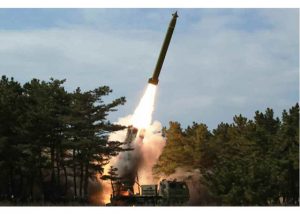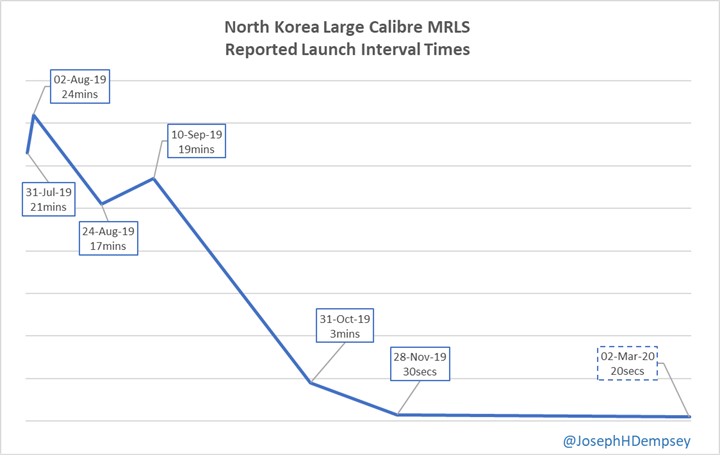North Korea’s Recent KN-25 Launches

North Korea successfully launched two short-range missiles during its military exercises on March 2, 2020, local time. The missiles were fired from a wheeled transporter-erector-launcher (TEL) positioned near the coastal city of Wonsan. The missiles covered a ground distance of roughly 240 km, reached a peak altitude of just 35 km and impacted in the Sea of Japan (East Sea). The time between launches was only 20 seconds, the shortest interval yet.
Initial reports from South Korean and the US intelligence officials indicated they “found some similarities in features between what [North Korea] fired today and those launched last year.” Photographs of the launch and available flight information are consistent with what is known as the KN-25, a long-range, guided artillery rocket.
It is approximately 8.2 m long, about 0.6 m in diameter and weighs just under 3,000 kg. The missile’s payload bay is too small to deliver a North Korean nuclear weapon but likely carries a 400 to 500 kg conventional, blast-fragmentation warhead instead. Its maximum range is estimated to be roughly 400 km, making the KN-25 a long-range weapon capable of attacking rear-echelon targets and suitable for deployment at the battalion level.
Flight testing of the KN-25 began in late August 2019, with the most recent launch representing the eleventh test to date, ten of which were successful. Test firings conducted on July 31 and August 2, 2019, may have involved the KN-25, but North Korea used ambiguous terminology to describe the projectiles tested on those dates. The first validated flight tests of the KN-25 took place in late August 2019, when North Korea identified the missile as a “super-large caliber” weapon. It should be noted that, as illustrated by Figure 1, on each of the five occasions the KN-25 is known to have been tested, the interval of time between firing the first and second missiles generally decreased. At the rate of this latest test, 20 seconds between firings, a full load of four missiles mounted on a TEL could be launched in about one minute.
In 2019, the KN-25 was likely operated by technicians and missile developers as part of the development and qualification process. The nine flight tests performed in 2019 are enough to demonstrate performance and obtain a measure of reliability under a controlled set of circumstances. Elsewhere, flight trials for short-range, battlefield missiles generally fire a couple dozen test articles under a wide range of environmental and operational conditions to provide a clearer picture of the system’s dependability. However, North Korea historically conducts fewer test flights than other nations tend to do, making the number of KN-25 launches so far consistent with Pyongyang’s missile development practices. The launches conducted this week occurred during military exercises, suggesting that they were operated by military personnel this time around and signaling that the KN-25 is likely now ready for military deployment.
Figure 1. North Korea Large Calibre MRLS Reported Launch Interval Times

The KN-25 is a battlefield weapon, one that the North Korean army would rely upon for conducting wartime missions. Military planners and commanders would undoubtedly want to know how well the system will work across a variety of operational conditions. This explains why North Korea has flight tested the missile eleven times to date. The KN-02 Toksa, KN-23 and KN-24 are similarly designed for battlefield use, and have been test launched in significant numbers, albeit fewer than is standard practice in other countries. Nonetheless, the testing pattern indicates that North Korea will rely on these missiles for warfighting, should hostilities break out.
The flight trials North Korea has employed in developing its strategic, long-range missiles, namely the Hwasong-12 intermediate-range ballistic missile and the Hwasong-14 and -15 intercontinental systems, included just five, two and one firings, respectively. These strategic systems remain unproven and have limited operational viability. Kim Jong Un cannot be certain that they will work properly if he orders their launch in a crisis. It is, therefore, reasonable to argue that Pyongyang may not view these long-range missiles as viable for nuclear warfighting. Rather, they are likely designed to deter attacks by threatening possible use against the United States under a limited set of circumstances. If North Korea wants to enhance its ability to deter an attack by the United States by threatening to strike the American homeland with nuclear weapons, it will need to increase the credibility of its long-range missiles through a more rigorous set of flight tests. To be sure, the number of test flights a new missile is subjected to provides a reasonable measure of how North Korea plans to use, or threaten to use them in the future, if necessary.
